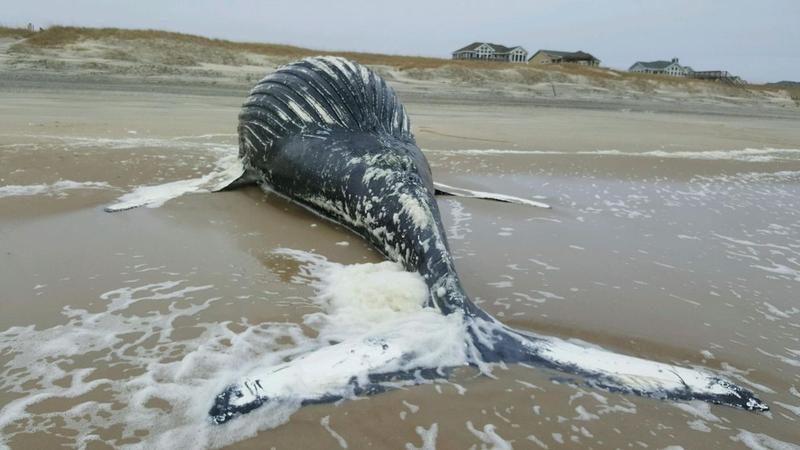
© Credit Karen Clar / The Virginia-Pilot
Beached Cuvier Whale at the Outer Banks found Sept. 2016
Beached whale sightings in North Carolina have been on the rise over the past decade - the most recent being in September with a rare, Cuvier's beaked whale that washed ashore in Nags Head.
Chris Thomas has more possible causes for the increased number of strandings along our coast.
North Carolina is home to 8 kinds of whale, including humpback, pilot, and blue - many of which are endangered.
William McLellan is a research biologist at the University of North Carolina in Wilmington and is the state coordinator for its Marine Mammal Stranding Program.
"North Carolina has one of the highest diversity of whale, potentially the highest diversity of whale and dolphin/porpoise species on the Atlantic Ocean."
McLellan helped the National Oceanic and Atmospheric Administration accumulate data - which indicated strandings have doubled between 2006 and 2015. There were, on average, 13 whale strandings a year in that span compared to an average of six between 1996 and 2004.That doesn't include other marine mammals like the bottle nosed dolphins, who experienced a widespread morbillivirus infection across along the east coast between 2013 and 2015
. Virginia and North Carolina had the highest and second highest number of reported dead porpoises during that span, respectively.Symptoms in porpoises include skin lesions and brain infections.
"It triggered an unusual mortality event at NOAA so it was a large investigation ended up over the course of
that 2-year-period, we looked at over 1,650 dead bottlenose dolphins on the east coast and North Carolina responded to 350 bottlenose during that event."There was a similar uptick in stranded pilot whales in North Carolina in the initial days of 2005. That was preceded by powerful sonar use in U.S. Navy exercises - though McLellan says the jury is still out on the cause and likely will remain so.
"It can never be determined - there was a possibility that was associated with Navy Sonar but it was never determined conclusively to be involved in Navy Sonar at the end of it."
But an oft-cited and ongoing issue is commercial fishing nets. A NOAA study published in 2014 stated anywhere between 13 species of dolphins and whales have been impacted by entanglement over the years and the commercial fishing industry has been a common target for environmentalists.
McLellan says the problem persists but it is getting better.
"There's efforts being done by state and federal organizations and universities and especially the fishing community itself - give them huge credit - for working with researchers and academic types in the federal government and state governments to mitigate and reduce that entanglement and fishing gear and reduce that mortality."
The uptick in stranded whale sightings may also be an indication of something positive: rebounding populations. That's been especially true for the humpback whale - one of the biggest comeback stories in conservationist's circles.
Once on the brink of extinction in the 1960s - the species' population has increased rapidly and were taken off the "endangered species" list last year after a 46-year-long stay.
"You know, in the good old days, there might be 100 calves born a year, if you're losing 10 percent of that, you're losing 5 normal animals that would die every year. Well now if you have 1,000 or 1,500 calves you're going to see 150 and that's just the exact same percentage there's just a much bigger issue going on."
Because of the myriad factors in place and the broad variety of species near the coast, there's no "silver bullet" causing whale stranding. McLellan says he hopes the public will take a more nuanced view of the issue in light of that.
Reader Comments
to our Newsletter